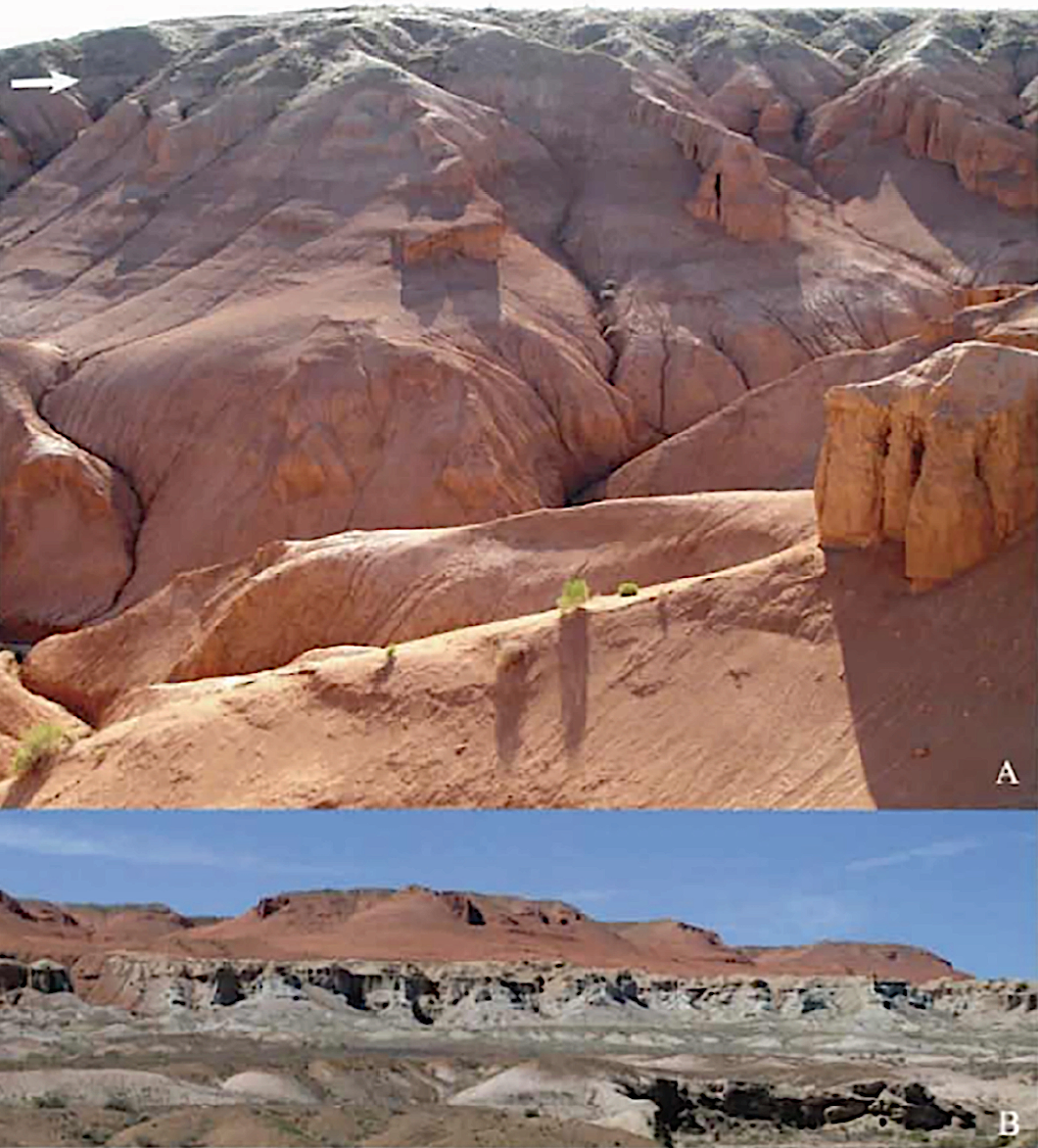Dingshanyanchi Fm
Type Locality and Naming
Junggar Basin NW. The type section is 29 km west to the Dingshanyanchi Salt Lake, Kalamagai Xiang of the Fuhai County, 78 km south to the Fuhai County, Geographical coordinates: 46°24′32.64”N; 87°28′29.04″E(GPS). The Dingshanyanchi Formation was named by Meng et al. (2008), separated from the Oligocene-Early Miocene Suosuoquan Fm.
[Figure: Geological map of the Dingshanyanchi Formation in the type locality.]
Lithology and Thickness
A suit of reddish clastic deposits, primarily massive muddy-siltstones, occasionally intercalated with thin-bedded conglomerates. The outcrops are marked by the horizons of relatively light or dark sediment cycles, lacking micro-laminate bedding. high-angle oblique-bedding is sometimes present. The lithology is rather unique, 46.2 m thickness at the type locality.
[Figure: Photos of the Dingshayanchi Formation. A, the upper part., the white arrow indicates the overlying green thick detrital deposits, B, the contact between the Dingshanyanchi and the underlying Halamagai Fm (Kekemaideng Fm).
Relationships and Distribution
Lower contact
Overlays the Middle Miocene Halamagai Formation (see above figure). Along the escarpment, the contact between the Halamagai Fm and Dingshanyanchi Fm varies from place to place. In some area, a hiatus is distinct between the two units, whereas in others they appear continuous.
Meng et al. (2008) considered that the Kekemaideng Fm is equivalent to the lower part of the Dingshanyanchi Formation, representing different facies. Recent studies also suggest that Kekemaideng Fm might underlay the Dingshanyanchi Formation (used here).
Upper contact
It is capped by a set of 5 m thick conglomerates of unknown age. Next higher formation is the (middle?) Pleistocene Xiyu Fm
Regional extent
Fuhai, Fuyun Counties, along the Ulungur River Drainage area.
GeoJSON
Fossils
Insectivora: Sonicidae gen.et sp.indet.(large), Soricidae gen.et sp. indet.(small), Talpidae gen. et sp. indet.; Chiroptera: Myolis sp., Lagormorpha: Alloptox gobiensis(Young,1932), Dersmatlolagus sp. Rodentia: Heterosminthu orientals (Schaub,1930), Protalactaga major (Qiu,1996), P. grabaui (Young,1927), Democrcetodon lindsayi (Qiu,1996), D. tongi (Qiu,1996), Megacnicetodon inenis (Qiu et al., 1981), M. pusillus (Qiu,1996), Paracricetulus schaubi (Young,1927), Plesiodipus leei (Young, 1927), Cricetodon sp. nov., Miodyromys sp., Myocrcetodontinae gen.et sp. indet., Plesiosciurus sp., Keramidomys jahlbuch (Qiu,1996), Sayimys sp., Rodentia fam. indet. Carnivora: Hemicyon cf. H. sehlini; Perissodactyla: Anchitheriun sp. Hipparion houfenense (upper part); Artiodaetyla: Cervoidea gen.et sp. indet. (lange), Cervoidea gen.et sp. indet. (small); Proboscidea fam. indet.; Terrestrial gastropod fossils of Pupilla cf. aeoli, Abida cf. frumentum, Punctum orphana, Gastrocopta sp., Vallonia cf. pulchella, Vertigo sp.. Aquatic gastropod fossils of Amnicola sp., Planorbarus sp..
Age
Depositional setting
Primarily eolian, partially reworked by fluvial processes.
Additional Information
